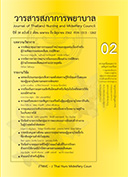Prevention of Metabolic Syndrome for School Adolescents: Participatory Action Research
Keywords:
adolescents, prevention programme, metabolic syndrome, participatory action researchAbstract
Objective: To develop a programme for the prevention of metabolic syndrome in adolescent schoolchildren through a participatory process, and to compare the adolescents’ nutritional conditions, waist circumferences, fasting blood sugar levels, triglyceride levels and cholesterol levels before and after participating in the programme.
Design: Participatory action research (PAR).
Methodology: The subjects in this study consisted of 40 students, 12 parents, 13 teachers/school administrators and 10 shopkeepers. Through participatory action, the subjects developed a programme to prevent metabolic syndrome in adolescents. Qualitative data were analysed using content analysis. Quantitative data were compared using paired T-test and Wilcoxon signed rank test.
Results: The PAR-developed metabolic syndrome programme was operated in four stages. In the frst stage, causes of the syndrome were identifed, namely, overconsumption; inappropriate food consumption habits; easy access to food; lack of environments conducive to exercise; and obstacles to behaviour change. The second stage engaged the adolescents, their families and school in planning the syndrome-preventing programme. The third stage, which was the implementation of the programme, required the adolescents to make self-inspired changes with support by their families and their school’s clear policy. The fnal stage was for regular self-monitoring and follow-ups. From the study, the participating adolescents’ post-experiment
fasting blood sugar levels were signifcantly lower than their pre-experiment levels (Z = -3.01, p < .001). However, no signifcant differences in their nutritional conditions, waist circumferences, triglyceride levels and cholesterol levels were found (p > .05).
Recommendations: In this study, the participatory process involving adolescents families, friends and school personnel enabled the subjects to change their behaviour, which could help prevent metabolic syndrome and lower their blood sugar levels. It was also found that clear communication and coordination led to stakeholders’ cooperation, which was a key factor in effectively preventing metabolic syndrome in adolescents.
Downloads
References
2. Magge SN, Goodman E, Armstrong SC, Committee on Nutrition. The metabolic syndrome in children and adolescents: shifting the focus to cardiometabolic risk factor clustering. Pediatrics 2017 Jul 24. pii: e20171603. PubMed PMID: 28739653. doi:10.1542/peds.2017-1603.60
3. Edwardson CL, Gorely T, Davies MJ, Gray LJ, Khunti K, Wilmot EG, et al. Association of sedentary behavior with metabolic syndrome: a meta-analysis.PloS One 2012;7(4)e34916. doi: 10.1371/journal.pone.0034916. Pubmed PMID: 22514690; PubMed Central PMCID: PMC3325927.
4. Aekplakorn W, Pakcharoen H, Thaikla K, Sateunnoppaklow W. The 5th report of Thai health by physical assessment
B.E. 2557 [Internet]. Bangkok: Health System Research Institute; 2017. [cited 2018 Apr 7]. Available from: https://www.hsri.or.th/researcher/research/newrelease/detail/7711. (in Thai).
5. Yamaoka K, Tango T. Effects of lifestyle modifcation on metabolic syndrome: a systematic review and metaanalysis. BMC Med 2012 Nov 14:138. doi: 10.1186/1741-7015-10-138. Pubmed PMID: 23151238; PubMed Central PMCID: PMC3523078.
6. Davis JN, Gyllenhammer LE, Vanni AA, Meija M, Tung A, Schroeder T, et al. Startup circuit training program reduces metabolic risk in Latino adolescents. Med Sci Sports Exerc 2011;43(11):2195-203.
7. Chaisri K, Klungtummeim K, Buajarean H. Clinical nursing practice guideline for management of obesity
in children: the synthesis of thesis. Journal of Royal Thai Army Nuring 2014;15(2):360-7. (in Thai).
8. Nudla P, Jittanoon P, Balthip K. Impact of an internetmediated over-consumption self-reminding programme in the body weight and consumption behavior of overnutrition adolescents. Thai Journal of Nursing Council 2017;32(1):32-46. (in Thai).
9. Bunnag A, Sangperm P, Jungsomjatepaisal W, Pongsaranunthakul Y, Leelahakul V. The effects of
behavioral modifcation for eating and exercising behavior in overweight adolescents. Journal of Nursing Science 2012;30(4):37-48. (in Thai).
10. Jiawiwatkul U. Participatory action research: concept, principle and lesson learned. Bangkok: PA Living;
2010. (in Thai).
11. Ozer, EJ, Ritterman ML, & Wanis, MG. Participatory action research (PAR) in Middle school: opportunities,
constraints, and key processes. Am J Community Psychol. 2010; 46(1-2):152-66.
12. Methakanjanasak P, Sota C. Health behavior modifcation of the metabolic syndrome: participatory action research.
Journal of Nursing Health Care 2016;34(2):14-23. (in Thai).
13. Praphasil O, Wattana C, Tharavanij T. Effects of promoting self-effcacy in a self-management program on selfmanagement behaviors, obesity, cardiovascular disease risk, and regression of metabolic syndrome among
persons with metabolic syndrome. Nursing Journal 2013;40(1):34-48. (in Thai).
14. Mohammed SA. (Re)Examining helath dispairties: Critical social theory in Pediatric Nursing. JSPN 2006;
11(1):68-71.
15. Bunnag A, Sanasuttipun S, Nookong A, Jungsomjetpaisal W, Pongsalanantakul Y. Metabolic syndrome prevention
model for adolescents Phase I [research report]. Bangkok: National Research Council of Thailand; 2014. (in Thai).
16. Kamsrichan W. Participatory action research. Bangkok: PA Living; 2011. (in Thai).
17. KimB, White K. How can health professionals enhance interpersonal communication with asdolescents and
young adults to improve health care outcomes?: systemetic literature review. Int J Adolesc Youth 2018;23(2):198-218.
18. Dickinson JK. A critical social theory approach to nursing care of adolescents with diabetes. Issues Comp Pediatr
Nurs 1999;22:143-52.
19. Tamiru D, Argaw A, Gerbaba M, Ayana G, Nigussie A, Jisha H, et al. Enhancing personal hygiene behavior
and competency of elementary school adolescents through peer-led approach and school-friendly: a quasiexperimental study. Ethiop J Health Sci 2017;27(3): 245-54.
20. Salvy SJ, Bowler JC, Germeroth L, Barkley J. Influence of peers and friends on overweight/obese youths’
physical activity. Exerc Sport Sci Rev 2012;40(3):127-32.
21. Zhang Y, Hurtado GA, Flores R, Alba-Meraz A, Reick M. Latino fathers’ perspectives and parenting
practices regarding eathing, physical activity, and screen time behaviors of early adolescent children:focus group fndings. J Acad Nutr Diet 2018;118(11):2070-80.
22. Hollis JL, Sutherland R, Campbell L, Morgan PJ,Lubans DR, Nathan N, et al. Effects of a “school-based” physical activity intervention on adiposity in adolescents from economically disadvantaged communities: secondary outcomes of the ‘Physical Activity 4 Everyone’ RCT. Int J Obes 2016;40(10):1486-93.
23. Jørgensen SE, Jørgensen TS, Aarestrup AK, Due P, Krolner R. Parental involvement and association with
adolescents’ fruit and vegetable intake at follow-up: process evaluation results from the multi-component school-based boost intervention. Int J Behav Nutr Phys Act 2016; 13(1):112. doi: 10.1186/s12966- 016-0435-1. PubMed PMID: 27782838; PubMed Central PMCID: PMC5080706.
24. Mühlig Y, Wabitsch M, Moss A, Hebebrand J. Weight loss in children and adolescents. Dtsch Arztebl Int 2014;111(48):818-24.







